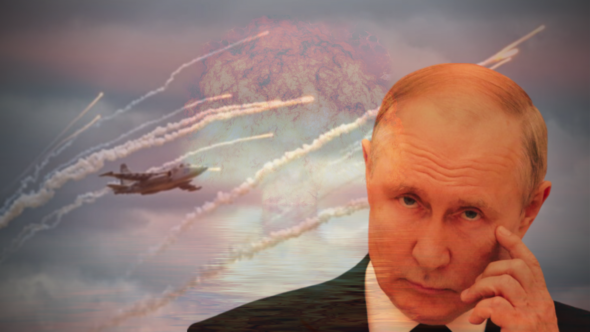For several months the Russian army has been developing strike capabilities on the border with Ukraine. It is not yet clear whether Moscow will actually decide to take military action. Without a doubt, however, the current military escalation is the most serious one, since the annexation of Crimea in 2014 – writes Mariusz Marszałkowski, editor at BiznesAlert.pl.
Will Russians repeat the gambit from 2014?
When analyzing Russia’s current actions, it is worth going back to the end of February 2014. It was then that Vladimir Putin announced an unexpected inspection of combat readiness in the Western and Southern Military Districts. Up to 150 thousand soldiers, thousands of pieces of military equipment and hundreds of aircrafts took part in these exercises (the largest since the collapse of the USSR). The maneuvers covered the area from the Kola peninsula in the Arctic to the coast of Russia on the Caspian Sea. This took place on February 26, two days before the start of the military operation to occupy the Crimea.
Then, as now, Russian politicians and officials assured that Russia would not use military force against Ukraine. Back then the words of Valentina Matviyenko, Chairwoman of the Federation Council, the higher chamber of the Russian parliament, drew a lot of attention. On 22 February 2014 she assured in an interview with Interfax that „the implementation of the scenario where force is used against Ukraine is not considered”. She repeated this on the radio station Moscow Echo on February 25. „Russia will not take any military action in Crimea, despite the presence of its own interests in the region,” Matviyenko said. The world found out a few days later how much these assurances were worth.
Interestingly, the same Matviyenko speaks in a similar tone also during the current crisis. On December 1, during a meeting with journalists, the president of the Federation Council, replied to a question on whether Russia will attack Ukraine: „Russia did not intend and does not intend to attack Ukraine. There is no basis for such claims. Those who spread such information are lying, telling nonsense and pursuing dirty politics.” According to her, Ukraine uses this rhetoric to divert attention from its difficult social and economic situation. „Neither the Russians nor the Ukrainians want any tensions. We are kindred nations,” she stressed.
In February and March 2014, the Russians took advantage of the organizational chaos inside the Ukrainian state and decided to occupy Crimea. They did this with relatively little means. It is estimated that that military operation involved about 30 thousand soldiers. These were mainly sub-divisions of the Airborne Troops, special forces, military intelligence units of the GRU, as well as aircraft crews and sailors of the Black Sea Fleet stationed in Crimea.
Now the situation looks different. Since March 2021 the Russians have been amassing troops on the border with Ukraine. They began to gather various types of military equipment such as tanks, artillery, armored vehicles and anti-aircraft systems at the border. These troops were deployed in field camps near the Ukrainian border. But then high-level meetings between Vladimir Putin and US President Joe Biden were held.
The world breathed a sigh of relief, because it seemed that the Russians had given up on implementing a military scenario against Kiev. As it turned out, despite the relative de-escalation, the Russians did not withdraw all the equipment from the border. Since late autumn 2021, we have been witnessing increased movement of military equipment, which seems inconspicuous, but is essential for any large-scale military operation, including pontoon bridges, engineering vehicles, field kitchens, tanks or ambulances and field hospitals.
According to estimates from intelligence services, as well as sources of the so-called OSINT (Open Source Intelligence – i.e., intelligence from publicly available sources), which are developed and analyzed by, among others, Konrad Muzyka from Rochan Consulting, the Russians have amassed at least 80 „skeletal” BGB (Battalion Battle Groups), on the borders with Ukraine, Russia and Belarus. A Battalion Combat Group is a basic, offensive formation, which has all the necessary elements for the performance of combat operations, i.e. artillery, anti-aircraft capabilities, support, engineering, etc. It is worth explaining what it means that these formations have a „skeletal” character. At the moment, the Russians are collecting the necessary equipment with a minimum crew capable of transit. We don’t see mass troop transports, e.g. infantry fighting vehicles landing. So far, Russia has also not moved many attack aircrafts to airports located closer to Ukraine. This means that despite the high tensions, Russians are not ready at the moment for a full-scale offensive. For this to happen, Moscow needs at least one to two more weeks.
What does Russia expect?
The most difficult thing in analyzing Russia’s behavior is to predict the motivation of the Kremlin. On the one hand, the propaganda talks about ensuring the security of the Federation by blocking Ukraine’s accession into NATO. Kiev’s entry to NATO is Moscow’s biggest fear, which it eagerly sells on the world stage. However, it is worth considering this narrative for a moment. Apart from the possibility of receiving the protective umbrella of the alliance, the mere presence of Ukraine in NATO would change little. The American military has been officially visiting Ukraine for the past 7 years to provide advice and trainings. The allied aviation uses the Ukrainian airspace without much difficulty. Western arms companies earn billions of dollars on modernizing the Ukrainian army. So what would change if Ukraine joined NATO?
Despite this, Russia officially demands a guarantee of security.
One could say, not without irony, that Russia deserves the security guarantees it had offered. In 1994, it signed the Budapest Memorandum, which granted Ukraine assurances of territorial integrity in exchange for handing over its nuclear arsenal to Russia. „Respect for integrity” by one of the four signatories lasted just 20 years.
The second factor, which may motivate the government of Russia to pursue its provocative policy, is what was mentioned by Valentina Matveyenko, except that it concerns Russia.
It’s no secret that the Russian economy, despite its huge potential, is growing very slowly. Western sanctions are not the only reason for this, because Russia’s economic development had not been proportional to its potential even before they were introduced. Still a third of Russia’s budget revenues come from the sale of hydrocarbons, while the high-tech industry is marginal. Apart from economic problems, Russia is also facing demographic problems. The country has been depopulating for years, and this doesn’t change despite the import of labor immigrants from Central Asia (who are culturally foreign to ethnic Russians, which is stressed in Russian discourse).
Currently, there are 2 million fewer Russians than after the seizure of the 2.5-million-strong Crimea in 2014, and this trend is accelerating due to the SARS-CoV-2 pandemic. Russia is handling it badly. This country has one of the highest mortality rates due to SARS-CoV-2, according to official statistics, which, as it turns out, have little to do with reality. This is visible in data on the death toll in a given period, which reveal huge numbers of „over the average” deaths that are not officially attributed to the pandemic.
Because of this, Russians themselves think little of their government. However, the Kremlin is not afraid of the discontent reflected in the polls. The Kremlin is afraid that the last straw will break the camel’s back, and a revolution will change the elites in Russia.
Hence the need to divert public attention from the crises of everyday life and shift it to something „bigger”. In 2014 that role was performed by Crimea. What about today?
Ukraine in 2014 and today
Unlike in 2014, the Russians will not be able to repeat their maneuver with the rapid annexation of Ukrainian territory. Today Ukraine is a different country than it was eight years ago: with a different army, economy and society. This is a country that, despite huge internal problems, similar to those plaguing Russia, has been waging a more or less intense war with Russia for 8 years. Today Ukraine’s army has more than 200 thousand soldiers, of which more than 150 thousand are only in the ground forces. To compare, the Polish army has less than 120 thousand troops in all types of armed forces.
Over the years Ukraine has been intensively modernizing its armed forces. It invested in modernizing its armors and military vehicles, developing the artillery, purchased hundreds of anti-tank sets produced locally. The Russian forces also underwent a technological transition at that time, but it must be remembered that it is the Ukrainians who have more than 400 thousand reservists who served on the demarcation line in the Donbass. These people (colloquially speaking) „sniffed” the powder. Few Russian soldiers took part in real military action, with a real opponent that has anti-tank forces, artillery or air support.
The entire potential military operation is also a challenge for Russian planners. Despite the gathering of large forces, they are stretched from Crimea, along the coast of the sea of Azov, the territory of Russia and the whole of Belarus, up to the border with Poland. Thanks to the continuous reconnaissance from the air, which is carried out by American and British reconnaissance aircrafts, it will be difficult for the Russians to hide the real directions of the attack, which in turn gives the Ukrainians a chance to deploy their own forces and resources as optimally as possible.
Will the Russians attack?
In the next few weeks, Russia will need to stop flexing its military muscles. It is not possible to maintain such a large number of armed forces in continuous mobilization. This is a very costly process both in military terms but also in social and economic terms. There is no doubt that Russia has already succeeded in its own way. Some leaders of Western countries have already announced their visits to Moscow in connection with the current situation. The Russians are also slowly convincing Western leaders of the inevitability of the coming war.
The Kremlin may seek peace in exchange for achieving some strategic goals. However, an equally important objective from Russia’s perspective would be to build divisions among its allies. Putin can now play the role of someone who must save his face before his society, which will prompt the politicians from some countries to make special concessions at the expense of, among others, Ukraine. This is a dangerous game, because even without the Russo-Ukrainian war, Moscow can count on a diplomatic success. The key may be the visit of Chancellor Olaf Scholz in Moscow, which is scheduled for February 15.
This meeting may decide whether the offensive against Ukraine will be launched. Especially since, according to various estimates, after February 20, the Russian forces on the border will reach full capacity to carry out combat operations.









